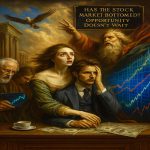Stock Market Bottom Predictions: A Fool’s Game—Watch Emotions Instead
“The only certainty in chaos is that the herd never lies—only those who ignore it risk losing everything.”
March 28 2025
When it comes to stock market bottom predictions, the noise is deafening. Everyone from your friendly neighbourhood pundit to the latest online guru claims they’ve cracked the code. But the truth is simple: instead of chasing predictions like a dog after its tail, you’d be better off reading the crowd. Forget the crystal balls and the supposed “perfect timing”—this is about raw market psychology, behavioral biases, technical analysis, and even the burro theory.
The Madness of Market Predictions
Every time the market takes a nosedive, pundits emerge like vultures, squawking about the impending bottom. They offer fancy charts and a parade of technical jargon—RSI, MACD, Fibonacci retracements—and claim the market has hit rock bottom. But here’s the kicker: these predictions are more like well-rehearsed parlour tricks than real insights.
Why? Because the market isn’t a machine that follows a neat script. It’s a living, breathing organism, pulsing with human emotions. And while some rely on meticulously designed algorithms, the real secret often lies in observing the crowd. The masses, with all their biases and irrational behaviour, can tell you more than any so-called “perfect” technical indicator.
Behavioral Biases: The Hidden Puppeteers
Let’s get real—our minds are wired to react irrationally to market moves. This is where behavioural biases come into play. Whether seasoned or green, investors are subject to biases like overconfidence, loss aversion, and the narrative fallacy. These aren’t just abstract concepts; they drive the market’s mood swings.
- Overconfidence: Many traders believe they have a golden ticket, a unique insight that sets them apart. They think, “I know when the bottom is coming,” even when the market sends contradictory signals. This can lead to disastrous timing, as the noise overwhelms genuine signals.
- Loss Aversion: The pain of losing often overshadows the joy of gaining. When markets dive, investors cling desperately to their positions or sell in a panic, missing out on the rebound.
- Narrative Fallacy: People love stories, and the market is no exception. Everyone spins a tale of doom in downturns, creating a self-reinforcing narrative that the bottom is near, even if the underlying fundamentals say otherwise.
✔️ Key Takeaway: Recognise these biases; they are the true indicators of where the herd is headed, far more than any technical tool might suggest.
Technical Analysis: Tools or Red Herrings?
Don’t get me wrong—technical analysis has its place. Tools like the Relative Strength Index (RSI) and Moving Average Convergence Divergence (MACD) can offer glimpses into market sentiment. For instance, an RSI below 30 often suggests oversold conditions, while a bullish MACD crossover might hint at a rebound. Yet, these signals are not foolproof. They work best when you understand the psychological context behind the numbers.
Imagine a scenario where the RSI screams “oversold” and the MACD shows a bullish reversal. Sure, the technical indicators align, but those signals might be premature if the market’s collective mindset is steeped in fear and uncertainty. Conversely, if the crowd is already showing signs of capitulation—panic selling, extreme sentiment readings—the technical signals might just confirm what the masses are doing.
Enter the Burro Theory
Now, let’s talk about the burro theory. Please think of the burro as that stubborn yet surprisingly wise creature that follows its path, often aligning with the crowd unexpectedly. The burro theory in markets is that sometimes, the simplest, most unassuming indicator—the crowd’s behaviour—can reveal more about the market’s true bottom than sophisticated technical models.
The theory suggests that if you watch the crowd closely, you’ll notice patterns that are hard to fake. For instance, when you see a relentless surge in capitulation volume and an extreme dip in investor sentiment, these are signs that even the “burros” of the market (the everyday investors) have hit their limit. They’ve essentially said, “I’m done.” And when that happens, it’s often a precursor to a rebound.
In practical terms, the burro theory advises monitoring extreme emotional reactions in the market. When fear dominates and the herd is selling off like mad, there’s a good chance that the market has bottomed out or is very close to doing so. It’s not about waiting for a precise moment; it’s about understanding that extreme behaviour is a signal.
✔️ Focus point: The burro theory teaches us that when the crowd’s fear is palpable, it’s not the time for predictions—it’s the time for action.
The Crowd: Your Most Reliable Indicator
Looking around, the crowd’s behaviour is often the most reliable indicator of a market’s true sentiment. Unlike models that can be tweaked and manipulated, the collective actions of investors are raw and unfiltered. You’ll notice a pattern: when everyone else runs for the exits, the real opportunity is knocking.
Consider how market bottoms have unfolded historically. During the 2008 financial crisis, while pundits debated the exact bottom, the herd’s panic was unmistakable. Institutional investors and savvy contrarians didn’t wait for perfect technical signals—they saw the mass capitulation and stepped in. They recognised that the market’s collective fear was a far more powerful indicator than any model could ever be.
This isn’t to say you should ignore technical analysis altogether. Instead, think of technical tools as secondary signals supporting what the crowd already tells you. If technical indicators align with a widespread emotional reaction among investors, you’re likely looking at a genuine bottom. And if they don’t? Well, it’s best to keep your eyes on the crowd rather than chasing elusive technical perfection.
The Danger of Chasing Perfect Timing
The quest for the perfect bottom is a fool’s errand. Our obsession with pinpointing the exact moment to buy is a trap set by our biases. Every investor has heard the myth: “Buy low, sell high.” In reality, the market doesn’t offer a clear-cut low or high. Instead, it’s a continuous ebb and flow influenced by emotions, news, and unpredictable global events.
Trying to time the market perfectly is like catching lightning in a bottle. Waiting for that perfect moment risks missing out on the broader trend. The true opportunity lies in understanding when most investors have given up hope, when their loss aversion and overconfidence have combined to create a perfect storm of fear.
For example, consider a scenario where pundits declare, “The market has bottomed out!” based on a temporary technical spike. Meanwhile, the crowd is still selling off in droves, driven by deep panic. If you follow the pundits, you might buy into a market still in freefall. But if you listen to the crowd—and see that the panic is still very real—you’re more likely to avoid a premature entry.
Integrating Behavioural Insights with TA and the Burro Theory
To truly master the art of market timing, you need to marry behavioral insights with technical analysis and the burro theory. Here’s how these elements come together:
- Start with the Crowd: Observe investor sentiment. Look for signs of extreme fear or euphoria. Tools like sentiment analysis, social media trends, and news sentiment can offer valuable clues.
- Support with Technical Analysis: Check the technical indicators once you’ve identified a potential emotional extreme. Is the RSI below 30? Is the MACD showing a bullish crossover? While not perfect on their own, these signals can provide confirmation when combined with the emotional data.
- Apply the Burro Theory: If the crowd’s behaviour is as extreme as it appears—if even the “burros” have reached their breaking point—it’s a strong signal that the market is nearing a bottom. This isn’t about precision but recognising when the herd’s emotions have been fully exploited.
Consider the 2020 market plunge amid the global pandemic. Many traditional indicators suggested a bottom might be near, but the raw, unfiltered panic of the masses truly marked the turning point. Investors attuned to the crowd’s behaviour—seeing the capitulation in real time—could enter the market at a significant discount. Their decisions weren’t based solely on technical charts but on the understanding that when fear is at its peak, the opportunity for recovery is massive.
✔️ Point of Contention: Combine the insights of behavioral psychology, technical indicators, and the burro theory to form a well-rounded view of market bottoms. Trust the crowd’s extreme actions as a beacon of opportunity.
Real-World Examples of Crowd-Driven Opportunities
Historical examples abound where reading the crowd proved far more effective than relying solely on technical predictions. During the 1987 Black Monday crash, technical signals were mixed and unclear. Yet, the overwhelming panic among retail investors provided a clear signal: the market was oversold. Savvy players who observed this mass exodus knew that the bottom was near and entered positions accordingly.
Similarly, in the aftermath of the 2008 crisis, while many analysts argued over the precise moment of the bottom, the sheer despair among the majority indicated a reversal. Institutions that monitored investor sentiment were able to step in before the rebound gained full momentum.
These cases illustrate that when everyone else is blinded by fear, there’s a window of opportunity for those willing to look beyond the surface. It’s not about being contrarian for the sake of it; it’s about recognising that the market’s collective behaviour often holds the key to its next move.
Embracing the Uncertainty
Here’s the brutal truth: uncertainty is the only constant in the stock market. No matter how many technical tools or behavioural studies you rely on, you’ll never have all the answers. Instead of seeking absolute certainty, focus on managing risk and understanding the broader emotional landscape.
Investors who embrace uncertainty learn to act decisively when the crowd’s fear reaches its apex. They know that market bottoms aren’t about perfection—they’re about seizing the moment when the collective panic creates a fertile ground for recovery. The key is to remain adaptable, to trust your instincts, and to let the evidence of the crowd guide you.
The Call for a New Mindset
Forget the notion of perfect timing. The real opportunity lies in letting go of the need for a flawless entry point and instead reading the signals from the market’s emotional barometer. When investors are gripped by extreme fear, it’s a clear sign that the market is undervalued—and that’s when the bold step in.
This is a call to arms for anyone tired of chasing elusive predictions. It’s time to embrace a mindset that values the crowd’s raw, unedited reactions. Use those reactions as your guide. Combine them with technical insights and the stubborn wisdom of the burro theory, and you have a recipe for success in even the most volatile markets.
Practical Steps to Read the Crowd
So, how do you go about reading the crowd? It starts with observation and discipline. Here are some practical steps:
- Monitor Investor Sentiment: Watch news headlines, social media, and market forums. Extreme pessimism or euphoria is a red flag.
- Watch Trading Volumes: Spikes in volume, especially during sell-offs, often signal capitulation. When everyone is rushing out, it’s a good time to consider stepping in.
- Track Technical Indicators: Use tools like RSI and MACD to confirm that the market is oversold. When these indicators align with crowd sentiment, it’s a strong signal.
- Be Patient: The market rarely bottoms out overnight. Wait for sustained evidence of panic before making your move.
- Diversify Your Entries: Instead of trying to time the exact bottom, consider a phased approach. Enter in tranches as the evidence of crowd capitulation becomes clearer.
Final Thoughts: Trust the Herd, but Know When to Act
The quest for the perfect bottom is a fool’s errand that distracts you from the real opportunities hiding in plain sight. Stock market bottom predictions may be alluring, but they often miss the mark. Instead, read the crowd. Understand that the market is not driven solely by numbers but by human emotion. When the masses are paralysed by fear, that’s your cue to act.
This isn’t about blindly following the herd—it’s about recognising that when extreme sentiment grips the market, it’s a sign that the tide is turning. The combination of behavioral biases, technical analysis, and the burro theory provides a robust framework to navigate these turbulent waters. It’s messy, it’s unpredictable, but it’s real. And if you can learn to harness that chaos, you’ll be well on your way to reaping rewards many only dream of.
The next time someone tells you they can predict the exact bottom of the market, remember: it’s not the prediction that matters—it’s the collective behaviour of the crowd. Focus on what the masses are doing, and let that guide your decisions. Ultimately, the market will always reflect its participants’ raw, unfiltered emotions. Embrace that truth, and you’ll find that even amid chaos, there is opportunity.
So, ignore the relentless chatter of bottom predictions. Instead, let the true indicators—the palpable fear and frenzy of the market—guide you. Be bold, be daring, and remember: in the chaos of the market, the most unassuming signals can lead to the greatest rewards.
Elevating Thought One Idea at a Time











